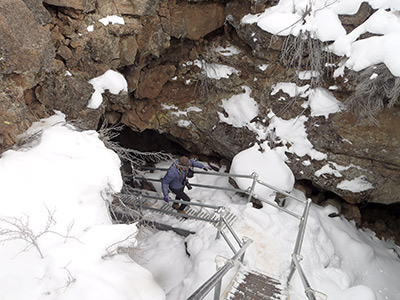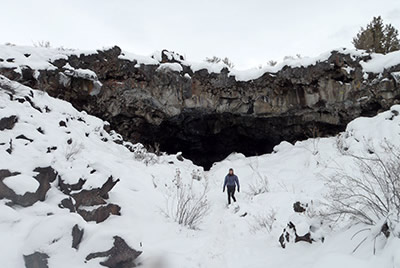Early Indians used them as water sources for their people and horses. Moonshiners used the waters to create illegal whiskey during Prohibition times. And, now, during the coldest winter months, visitors to Lava Beds National Monument can visit ice caves, not just to tap into history, but to be dazzled by phantasmagorical formations of ice.
| |
Ice formations and crystal in Crystal Ice Cave are simply phantasmagorical |
|
The Lava Beds are often called "The Land of Burnt Out Fires" for its harsh, ruggedly daunting landscape of hardened lava. Located in far northern California, the area is known for the geology that created its daunting landscape, one that includes more than 770 lava tube caves. Some of those caves and odd landforms were used by Modoc Indians to their advantage during the Modoc War of 1871-72. For months the Modocs stymied a much larger Army force, using the rock formations of Captain Jack's Stronghold to hold off would-be assaults, using the caves as crude living quarters and using their knowledge of the land to obtain water.
| |
Zane Grey, who years later visited and explored the area with local ranchers, used the caves as locations in his 1927 novel, Forlorn River, which is set in the neighboring Tulelake Basin and what is now Lava Beds National Monument. |
|
 |
|
| |
Forlorn River is partially set in the Lava Beds |
|
Using creative license, Gray wrote how the Indian guide "soon led into the region of the ice caves. Huge holes gaped abruptly; black vacant apertures stared from under ledges; windows of mysterious depths show right out of the gray pumice...Some of the holes were fifty feet deep and twice as long, black and jagged-walled, brush-filled, with dark doors of caves somewhere at the bottom. Every one of them led into a cave. And down in those caves there was always supposed to be ice, from which cold crystal water flowed."
| |
|
|
At least one of those caves had earlier been used as a water source by Charles Caldwell, who in the late 1800s toughened the feet of Clydesdale horses, mules and donkeys that he, and later his widow, sold to buyers. Another ice cave, first called Bearpaw and later by its present name, Merrill, was a horse camp in the early 1900s. By the 1920s its waters were used to make moonshine until 1923 when it became a resort with a road house, dance hall and hotel. |
|
| |
Mushpot Cave was used by bootleggers |
|
|
|
| |
|
|
|
|
| |
In recent years, the ice in Merrill Cave has melted. Only pockets of ice remain in other caves. After years of fluctuations, Crystal Ice Cave was locked and remains open to only limited ranger-guided visits December through March. While any of the park's 22 semi-developed caves are good choices – some of the most popular include Valentine, Catacombs, Golden Dome, Merrill and Skull – Crystal is the lifetime treat. |
|
 |
|
| |
|
|
Exiting Merrill |
|
| |
There's much to see in Crystal Cave |
|
Exploring Crystal is a challenging but not daunting experience that includes down-climbing to the cave's locked entrance, descending an ice-frozen ladder and, with the aid of a rope, sliding or backing down an icy slope.
| |
Stalagmites create a fantasyland of formations |
|
During a recent group tour led by ranger Katrina Smith, she and I were the only people who had previously visited Crystal Cave. I listened and grinned as first-timers, bedazzled by the sights, "oohed" and "aahed." But then so did I. We scrambled through the fragile subterranean fantasyland of ice-formed stalactites, stalagmites, columns, curtains, oddly formed ice blocks – some resembling spears, modernistic sculptures, crystalline horns, jagged daggers and upright torpedoes – and, as the cave's name implies, zillions of hexagonal, or six-sided crystals.
| |
Crystals give the cave its name |
|
The tour meanders through segments of the multilevel cave, which drops about 150 feet below the surface. Although it's only 960 feet long, its intermittently connected levels make the cave's total length about 1,800 feet. The tours don't cover the cave's entire distance, but it's sometimes possible to work around one of the cave's most eye-popping features, a 15-foot tall waterfall-like ice column, to a room with an ice floor and more weirdly-wonderfully shaped ice blocks.
Getting a up close view |
|
Frozen soldiers |
Crystal is the park's gem, but winter is the season when many caves, especially near their entrances, take on distinct personalities. Moisture seeping through cracks or dripping from ceilings freezes and creates watery stalagmites, or “smurfs.” At some, including the entrance to Indian Well Cave, just a short walk from the park's visitor center, rows of side-by-side formations might be mistaken for frozen, snow-cloaked Chinese terracotta soldiers.
Winter is a season to trace the footsteps of early Modocs, horsemen, Zane Gray and moonshiners. Lava Beds National Monument is a fascinating anytime visit, but seeing the caves in winter is simply phantasmagorical.
If You Go
Stops are required at the visitor center before exploring any cave to protect against spreading the white-nose syndrome, a disease that has caused extensive bat deaths east of the Rocky Mountains. Free flashlights can also be checked out and rangers can recommend caves to visit. Several caves, including those along Cave Loop Road near the Lava Beds visitor center, are easily accessible. Recommended is the helpful guide, "Lava Beds Caves," by Charlie and Jo Larson that has maps, descriptions and histories of many caves.
Pre-planning is necessary for ranger-guided tours of Crystal Ice Cave. Tours for up to six people, which began in December and continue through March, are offered only at 1 p.m. on Saturdays because of the cave's sensitive formations. Tours last 3 to 3-1/2 hours and involve descending and ascending a sloped ice floor with the aid of a rope, crawling through tight holes and walking on rocky floors. Helmets, headlamps, gloves, knee pads, sturdy shoes and layers of warm clothing are necessary.
Reservations are taken beginning at 8:30 a.m. Saturdays for dates three weeks in advance by calling 530-667-8113. Preference is given to people waiting at the Lava Beds visitor center when it opens. If unsuccessful, ask to be placed on a waiting list.
For information on Lava Beds visit the website at www.nps.gov/labe.
|
|
 |
| J.D. Howard painted Crystal Cave's name near its entrance |
|
Caver near the entrance of Indian Well Cave |
About the Author
Lee Juillerat has been exploring Lava Beds caves for decades, especially after learning he lives in the Klamath Falls house that was once the home of J.D. "Judd" Howard, the discoverer of many Lava Beds cave and the person most responsible for the area being designated as a national monument. Lee can be contacted at 337lee337@charter.net.
J.D. Howard's story, and other historical information about the Lava Beds, is included in "Unforgiving Landscape: Lava Beds National Monument and the Modoc War," a publication of the Shaw Historical Library, www.library.oit.edu/shaw/publications.html . Another historical source is "The Center of the World, The Edge of the World: A History of Lava Beds National Monument," by Frederick L. Brown. |
|
|